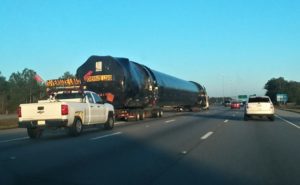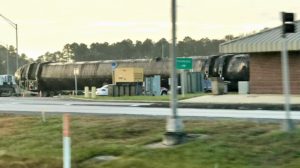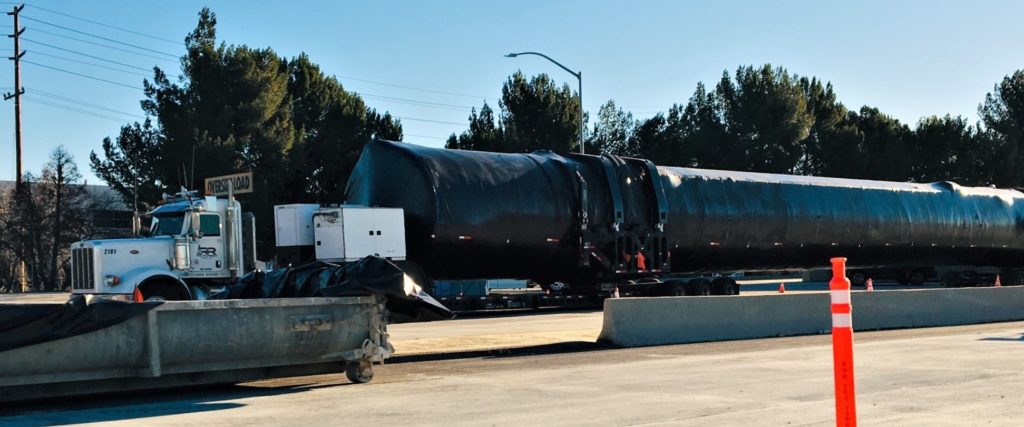

News
SpaceX Falcon 9 booster spied on highway as triple-satellite launch moves right
A SpaceX Falcon 9 booster was spotted heading north from the company’s Hawthorne, California factory on January 22nd, signifying a likely shipment of the flight-proven rocket that will help launch Canada’s trio of Radarsat Constellation Mission satellites.
Delayed from mid-February to early March 2019 after an unplanned landing anomaly damaged the Falcon 9 originally assigned to the mission, the shipment of a different booster to Vandenberg Air Force Base (VAFB) helps to narrow down the rocket now likeliest to launch the Canadian Space Agency’s (CSA) radar satellite constellation.
https://twitter.com/GoForStaging/status/1088174203298230272
Do the Booster Shuffle!
Thanks to a hydraulic pump failure that led Falcon 9 B1050 to land (albeit softly and in one piece) in the Atlantic Ocean last December, the imminent launch of two booster-dense Falcon Heavy missions, and the thus far schedule-shy orbital launch debut of Crew Dragon, SpaceX’s fleet of available boosters – all flight-proven – can be succinctly summarized as “B1046 thru B1049”.
B1050’s future is uncertain after suffering a smashed interstage and soaking in salt water for several days, while B1051 is definitively assigned to Crew Dragon’s orbital launch debut, known as Demo-1 (DM-1). Falcon 9 B1052 and B1053 are unknown quantities and B1054 was expended after a high-value US Air Force launch, also SpaceX’s final mission of 2018. It’s probably safe to bet that B1052, B1053, and B1055 will be the next three boosters to support a Falcon Heavy launch (or two), currently NET March and April 2019. All three of those Falcon Heavy (FH) boosters have completed static fire tests in Texas and both side boosters arrived at SpaceX’s Florida facilities within the last ~6 weeks.
- A Falcon Heavy side booster was spotted eastbound in Arizona on November 10th. (Reddit – beast-sam)
- The second (and third) flight of Falcon Heavy is even closer to reality as the first new side booster heads to Florida after finishing static fire tests in Texas. (Reddit /u/e32revelry)
- Reddit user wedatsaints captured this photo of the second Falcon Heavy side booster traveling through Mississippi on Jan 16. (Reddit /u/wedatsaints)
- SpaceX Facebook group member Joshua Murrah captured the second Falcon Heavy side booster to arrive in Florida in the last month. (Joshua Murrah, 01/17/19)
- A booster – likely the next Falcon Heavy center core – was vertical at McGregor’s S1 static fire stand. (Instagram /u/tcryguy)
Assuming that Falcon Heavy Flight 2 and 3 use the same exact boosters, SpaceX production technicians and engineers may already be nearing the completion of another Falcon 9 booster (B1056, presumably) at the Hawthorne factory, although they are likely 1-2 weeks away from that milestone. If, Falcon Heavy Flight 3 (presumed to be the USAF’s STP-2 mission) does not reuse all three first stage boosters from Flight 2 (commercial payload Arabsat 6A), then Hawthorne will have to build, ship, and test anywhere from 1-3 additional boosters between now and April 2019. In the latter scenario, all unflown – mid-build or completed – Falcon boosters would be ‘claimed’ between now and March or April.
Put in another way, short of opting for a delay that could stretch 1-4 months or longer, the Canadian Space Agency (CSA) and Radarsat prime contractor MDA will have to accept one of SpaceX’s flight-proven Falcon 9s.
Falcons on wheels
Thanks to SpaceX’s trusty and well-worn method of using good old trucks and roads to transport Falcon 9 and Heavy boosters, upper stages, fairings, landing legs, and much more cross-country, spaceflight fans have long taken advantage of opportunities – rare and fleeting as they might be – to spot and track SpaceX hardware on public roads. Put simply, a lot of people are excited about SpaceX or are at least familiar and curious enough to know someone to share a photo or observation with. As a result, the community averages dozens of ‘core spottings’ per year. With a little intuition, the process of elimination, a few sources, and some wild guesses, this allows unofficial fans to (very roughly) paint a picture of SpaceX’s fleet of rockets.
- Reddit user intamin1 spotted a Falcon 9 booster northbound between Hawthorne and Vandenberg on Jan 22. (Reddit /u/intamin1)
- A booster – likely the next Falcon Heavy center core – was vertical at McGregor’s S1 static fire stand. (Instagram /u/tcryguy)
For example, the Falcon 9 spotted in Valencia, CA on January 22nd by Reddit user intamin1 could theoretically be any SpaceX booster currently in existence. By knowing the rough state of SpaceX’s fleet (as described above) and observing that the booster was northbound between Hawthorne, CA (the factory) and Vandenberg Air Force Base (VAFB) on Jan 22, a great deal can be intuited. Bound for SpaceX’s West Coast launch complex (SLC-4), it ought to be flightworthy. Knowing that a Falcon Heavy center booster was on SpaceX’s McGregor, Texas static fire stand on January 10th means that the spotted booster can’t (or at least shouldn’t) be coming from Texas, as Falcon Heavy has no known launches planned from VAFB. The process of testing, inspecting, and preparing Falcon boosters for cross-country shipment is also not easily rushed.
On the East Coast, SpaceX needs to launch communications satellite PSN-6 and Spaceflight rideshare GTO-1 in mid to late February. With no new boosters expected to be easily available for months and PSN-6/GTO-1 already entering into the phases of payload fueling, integration, and fairing encapsulation, it can be all but guaranteed that a flight-proven booster was assigned to the mission months ago and is now nearly ready for its third flight somewhere in Cape Canaveral, FL.

Given that B1046 and B1049 are on the West Coast after conducting launches from VAFB and that B1050 is out of circulation for the time being, only B1047 and B1048 remain (in theory) on the East Coast, both having flown two missions. B1048 was recently spotted and confirmed in photos of SpaceX’s Pad 39A integration hangar, although Falcon 9 B1051 and the first orbit-ready Crew Dragon were the center of attention.
B1047 completed its second launch in mid-November 2018 and returned to one of SpaceX’s Florida hangars for refurbishment around Nov 21. Unless any number of locals and bystanders somehow missed it, neither booster has left the Cape since arriving. Meanwhile, B1048 is currently the best-known candidate at hand for SpaceX’s Crew Dragon In-Flight Abort (IFA) test, expected to occur no earlier than spring 2019 and entirely dependent upon the successful launch, reentry, recovery, and refurbishment of the DM-1 capsule to proceed. As a result, the only booster that is realistically available for PSN-6/GTO-1 is Falcon 9 B1047 for what would be its third launch.
Few of my favorites from today's Pence visit to #SpaceX pad 39A. In first photo, from left to right: Previously flown B1048, booster for DM-1, Crew Dragon for DM-1. Look at the size of that Merlin engine bell.
More photos: https://t.co/6dMbampx2c pic.twitter.com/3KmjVj4Rvf
— Emre Kelly (@EmreKelly) December 18, 2018
Assuming B1048 did not manage to make it from Cape Canaveral to Central California without a single spotting, the only rockets available for the RCM mission are B1046 and B1049. B1049 completed its second launch – Iridium-8 – just weeks ago and returned by drone ship to Port of LA on January 13th, whereas Falcon 9 B1046 – after completing its historic third launch – completed recovery and was snug in a Hawthorne, CA refurbishment bay by December 17th, 2018. Going off of Occam’s Razor, B1046 is the clear victor for the launch of RCM, although a ~60-90-day turnaround for the already thrice-flown booster could be a stretch. B1049, however, would have barely a single month for refurbishment and inspections.
In the last week or two, RCM stakeholders were provided an updated launch target, delaying the mission by approximately two weeks to a window that begins February 28th with the implication being that the launch is now expected NET early March. If that date is recent and from SpaceX, B1046 is the most practical option, with B1049 thus filling its refurbishment bay in Hawthorne, CA around the same day. If a risk of a 30-day or greater delay is tolerable for CSA and MDA, then B1049.3 would likely be a more optimal fit for their risk tolerance profile. Time will tell!
News
Tesla UK sales see 14% year-over-year rebound in June: SMMT data
The SMMT stated that Tesla sales grew 14% year-over-year to 7,719 units in June 2025.

Tesla’s sales in the United Kingdom rose in June, climbing 14% year-over-year to 7,719 units, as per data from the Society of Motor Manufacturers and Traders (SMMT). The spike in the company’s sales coincided with the first deliveries of the updated Model Y last month.
Model Y deliveries support Tesla’s UK recovery
Tesla’s June performance marked one of its strongest months in the UK so far this year, with new Model Y deliveries contributing significantly to the company’s momentum.
While the SMMT listed Tesla with 7,719 deliveries in June, independent data from New AutoMotive suggested that the electric vehicle maker registered 7,891 units during the month instead. However, year-to-date figures for Tesla remain 2% down compared to 2024, as per a report from Reuters.
While Tesla made a strong showing in June, rivals are also growing. Chinese automaker BYD saw UK sales rise nearly fourfold to 2,498 units, while Ford posted the highest EV growth among major automakers, with a more than fourfold increase in the first half of 2025.
Overall, the UK’s battery electric vehicle (BEV) demand surged 39% to to 47,354 units last month, helping push total new car sales in the UK to 191,316 units, up 6.7% from the same period in 2024.
EV adoption accelerates, but concerns linger
June marked the best month for UK car sales since 2019, though the SMMT cautioned that growth in the electric vehicle sector remains heavily dependent on discounting and support programs. Still, one in four new vehicle buyers in June chose a battery electric vehicle.
SMMT Chief Executive Mike Hawes noted that despite strong BEV demand, sales levels are still below regulatory targets. “Further growth in sales, and the sector will rely on increased and improved charging facilities to boost mainstream electric vehicle adoption,” Hawes stated.
Also taking effect this week was a new US-UK trade deal, which lowers tariffs on UK car exports to the United States from 27.5% to 10%. The agreement could benefit UK-based EV producers aiming to expand across the country.
News
Tesla Model 3 ranks as the safest new car in Europe for 2025, per Euro NCAP tests
Despite being on the market longer than many of its rivals, the Tesla Model 3 continues to set the bar for vehicle safety.

The Tesla Model 3 has been named the safest new car on sale in 2025, according to the latest results from the Euro NCAP. Among 20 newly tested vehicles, the Model 3 emerged at the top of the list, scoring an impressive 359 out of 400 possible points across all major safety categories.
Tesla Model 3’s safety systems
Despite being on the market longer than many of its rivals, the Tesla Model 3 continues to set the bar for vehicle safety. Under Euro NCAP’s stricter 2025 testing protocols, the electric sedan earned 90% for adult occupant protection, 93% for child occupant protection, 89% for pedestrian protection, and 87% for its Safety Assist systems.
The updated Model 3 received particular praise for its advanced driver assistance features, including Tesla’s autonomous emergency braking (AEB) system, which performed well across various test scenarios. Its Intelligent Speed Assistance and child presence detection system were cited as noteworthy features as well, as per a WhatCar report.
Other notable safety features include the Model 3’s pedestrian-friendly pop-up hood and robust crash protection for both front and side collisions. Euro NCAP also highlighted the Model 3’s ability to detect vulnerable road users during complex maneuvers, such as turning across oncoming traffic.
Euro NCAP’s Autopilot caution
While the Model 3’s safety scores were impressive across the board, Euro NCAP did raise concerns about driver expectations of Tesla’s Autopilot system. The organization warned that some owners may overestimate the system’s capabilities, potentially leading to misuse or inattention behind the wheel. Even so, the Model 3 remained the highest-scoring vehicle tested under Euro NCAP’s updated criteria this year.
The Euro NCAP’s concerns are also quite interesting because Tesla’s Full Self-Driving (FSD) Supervised, which is arguably the company’s most robust safety suite, is not allowed for public rollout in Europe yet. FSD Supervised would allow the Model 3 to navigate inner city streets with only minimal human supervision.
Other top scorers included the Volkswagen ID.7, Polestar 3, and Geely EX5, but none matched the Model 3’s total score or consistency across categories. A total of 14 out of 20 newly tested cars earned five stars, while several models, including the Kia EV3, MG ZS, and Renault 5, fell short of the top rating.
Elon Musk
Why Tesla’s Q3 could be one of its biggest quarters in history
Tesla could stand to benefit from the removal of the $7,500 EV tax credit at the end of Q3.

Tesla has gotten off to a slow start in 2025, as the first half of the year has not been one to remember from a delivery perspective.
However, Q3 could end up being one of the best the company has had in history, with the United States potentially being a major contributor to what might reverse a slow start to the year.
Earlier today, the United States’ House of Representatives officially passed President Trump’s “Big Beautiful Bill,” after it made its way through the Senate earlier this week. The bill will head to President Trump, as he looks to sign it before his July 4 deadline.
The Bill will effectively bring closure to the $7,500 EV tax credit, which will end on September 30, 2025. This means, over the next three months in the United States, those who are looking to buy an EV will have their last chance to take advantage of the credit. EVs will then be, for most people, $7,500 more expensive, in essence.
The tax credit is available to any single filer who makes under $150,000 per year, $225,000 a year to a head of household, and $300,000 to couples filing jointly.
Ending the tax credit was expected with the Trump administration, as his policies have leaned significantly toward reliance on fossil fuels, ending what he calls an “EV mandate.” He has used this phrase several times in disagreements with Tesla CEO Elon Musk.
Nevertheless, those who have been on the fence about buying a Tesla, or any EV, for that matter, will have some decisions to make in the next three months. While all companies will stand to benefit from this time crunch, Tesla could be the true winner because of its sheer volume.
If things are done correctly, meaning if Tesla can also offer incentives like 0% APR, special pricing on leasing or financing, or other advantages (like free Red, White, and Blue for a short period of time in celebration of Independence Day), it could see some real volume in sales this quarter.
You can now buy a Tesla in Red, White, and Blue for free until July 14 https://t.co/iAwhaRFOH0
— TESLARATI (@Teslarati) July 3, 2025
Tesla is just a shade under 721,000 deliveries for the year, so it’s on pace for roughly 1.4 million for 2025. This would be a decrease from the 1.8 million cars it delivered in each of the last two years. Traditionally, the second half of the year has produced Tesla’s strongest quarters. Its top three quarters in terms of deliveries are Q4 2024 with 495,570 vehicles, Q4 2023 with 484,507 vehicles, and Q3 2024 with 462,890 vehicles.
-

 Elon Musk5 days ago
Elon Musk5 days agoTesla investors will be shocked by Jim Cramer’s latest assessment
-

 News1 week ago
News1 week agoTesla Robotaxi’s biggest challenge seems to be this one thing
-

 Elon Musk2 weeks ago
Elon Musk2 weeks agoFirst Look at Tesla’s Robotaxi App: features, design, and more
-

 News2 weeks ago
News2 weeks agoWatch Tesla’s first driverless public Robotaxi rides in Texas
-

 News2 weeks ago
News2 weeks agoWatch the first true Tesla Robotaxi intervention by safety monitor
-

 Elon Musk2 weeks ago
Elon Musk2 weeks agoTesla officially launches Robotaxi service with no driver
-

 Elon Musk1 week ago
Elon Musk1 week agoA Tesla just delivered itself to a customer autonomously, Elon Musk confirms
-

 News2 weeks ago
News2 weeks agoTesla Robotaxi rollout proves that Elon Musk still delivers, even if it’s late



























